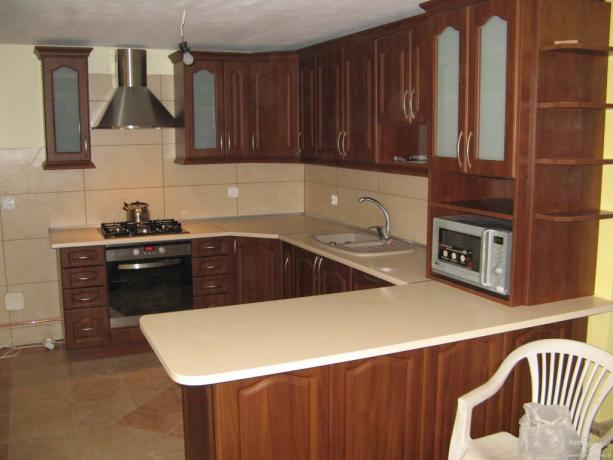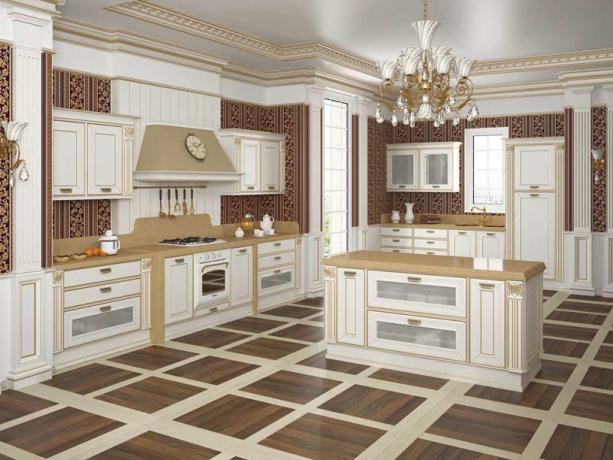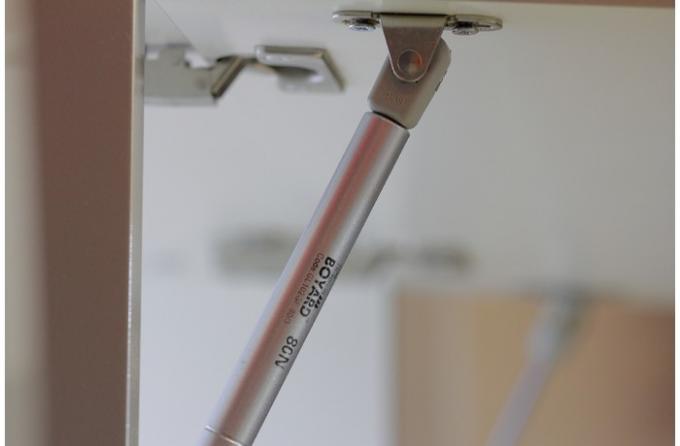Content
- 1 Facades - front surface
-
2 Laminated chipboard
- 2.1 Advantages of film facades
- 2.2 Disadvantages of laminated boards
-
3 Plastic chipboard
- 3.1 Pros of plastic
- 3.2 Cons of plastic facades
-
4 MDF facades
- 4.1 Advantageous sides
- 4.2 Disadvantages of MDF
-
5 Facades with glass
- 5.1 Negative qualities of combined facades
-
6 Stratified plastic facades
- 6.1 Advantages of multilayer facades
- 6.2 Disadvantages of stratified plastic
-
7 Veneered facades
- 7.1 Veneer features
- 7.2 Disadvantages of veneered facades
-
8 Natural wood
- 8.1 Advantages of natural facades
- 8.2 Cons of wood
- 9 Aluminum facades
- 10 Conclusion
There are many different materials for making furniture, in particular for kitchen sets. Each has its own characteristics, properties that many do not know about. That is why we have compiled this article - we presented the advantages and disadvantages of the materials used for everyone to see.

The appearance of the kitchen - how it should be in your mind
Facades - front surface
If the base of furniture cabinets is made of laminated chipboard - the most common material at the moment, there are many more materials for the front part..
Someone will say that the most important difference for everyone is the price, and in some ways they will be right. Based on cost, we'll start with the cheapest deals and end with the most expensive solution.
Laminated chipboard

This is how the laminated facades will look like
This option is something akin to chipboard, which is used for frames, but with a higher quality laminate. There are a lot of color schemes: from monochromatic (white, yellow, blue, red, beige and black) to identical to natural colors (wooden textures).
Of course, the more unusual the coloring, the more expensive is 1 square meter of laminated facades.
Note!
The base of the chipboard can be impregnated with moisture protective agents, which will protect the material from high humidity.
Advantages of film facades
- Availability. If you're on a tight budget, then this is the option for you.
- Manufacturing speed. If wooden kitchen fronts require compliance with a whole cycle of working moments, then the chipboard is only necessary, just sawn to the required dimensions and edge trimmed.
- Easy to clean. You can use alcohol-based products without fear of damage to the surface.
Disadvantages of laminated boards
- A very poor view. Yes, there are shades of different trees, but they look "poor" in the kitchen. The surface is always flat, no variety of shapes and reliefs - due to the fact that this material for kitchen furniture does not lend itself to "artistic" interference.
- It is not possible to use the veneered facade as a glass frame.
Plastic chipboard

Plastic fronts with 2 mm PVC edge along the perimeter
Again, the basis is particle board, however, the coating is much more "valuable". The main feature of such kitchen facades, this is the ability to create glossy surfaces at an affordable price.
Pros of plastic
- Reliable material. It is quite difficult to damage it: scratches and dents can appear only after strong mechanical shock.
- The widest range of different shades and colors.
Note!
Experts believe that plastic can replace glossy MDF, while you can save on such a difference.
- High moisture resistance. It is the best material used in rooms with high humidity.
Cons of plastic facades
- On a glossy surface, you can distinguish "shagreen". This is due to the impossibility of creating a perfectly flat surface of the chipboard.
- After damage to the outer coating, it is not possible to restore such a facade.
MDF facades
Another common material for kitchen furniture, used as front pieces.
There are several types of MDF facades:
- Veneered. The surface is identical to natural wood, it is almost impossible to distinguish them.
- Painted. Glossy surfaces that blend in perfectly with any decor.
- Plastic. An analogue of facades based on chipboard with plastic.
- Easily amenable to "artistic" processing. MDF has a fine-grained base that can be milled into intricate shapes.
- Many different shades. A particularly wide range of paints that have different effects: gloss, metallic, chameleon and others. Several options can be seen in the photo below.
Advantageous sides

Painted MDF - classic gloss

Metallic bronze - a stylish solution for the kitchen
- Looks worthy in any kitchen.
Disadvantages of MDF
- Durability: the paint is easily damaged; veneer exfoliates over time.
- A difficult stage of restoration, since all the slabs are procured at the factory, therefore, the replacement of the marriage is the manufacture of a new part. And if this happened through your fault, then this is also an additional cost.
- Special care is required for veneer and paint. Firstly, you cannot use abrasive substances, and secondly, over time, the facades fade from ultraviolet rays.
Memo!
The process of making a kitchen with MDF facades can take about 2 months.
Facades with glass
The unusual kitchen option, however, is highly sought after in the western market.
The production looks like this:
- Tempered glass is made 5 mm thick.
- It is glued to MDF boards.
- The reverse side of MDF is covered with a protective film.
- The ends are closed with an aluminum profile.
Feature glass kitchen facades is the ability to use any drawing as a basis. The color scheme for this has no restrictions.
The advantages include the inability to damage the paint.
Negative qualities of combined facades
- Like any glass - glass on MDF requires special care. Any greasy stains and scuffs are clearly visible on the surface.
- If the glass is cracked, then the restoration of the facade will cost you a significant amount.
Note!
It is quite difficult to make such products with your own hands, so the option with self-replacement is no longer valid.
Stratified plastic facades
You ask, how do they differ from those that were proposed earlier? The most important difference is that the base is not made of pressed shavings, but consists of many thin layers of plastic, which are framed at the ends with an aluminum frame.
Advantages of multilayer facades
- Lightweight material. Such a facade does not put additional stress on the cabinet.
- High wear resistance. The surface is almost impossible to damage: the appearance of a dent can only be associated with a hammer blow.
- Simple maintenance. Plastic can be cleaned with any means used for facades.
Disadvantages of stratified plastic
The disadvantage is the overpricing and limitation in use for different styles. This is due to the aluminum frame, which is fixed around the perimeter and cannot be replaced.
Veneered facades

Kitchen with a harmonious combination of veneer fronts and aluminum frames with glass inserts
The option is as close as possible to natural wood, the cladding is made from a thin saw cut of trees: oak, wenge, ebony, zebrano, walnut and alder. The surface is treated with a protective varnish, which, unfortunately, only protects against dirt and moisture.
Veneer features
- Double-sided veneering gives the impression that the facades are made of solid wood.
- Resistant to temperature extremes and high humidity.
Disadvantages of veneered facades
- Care required: use of detergents is contraindicated.
- Coffee and wine stains are hardly removed from light-colored facades.
Note!
Restoration is impossible; the damaged facade will have to be completely replaced.
Natural wood

Natural wood looks in the interior even without additional decorative elements
The most environmentally friendly, but also the most expensive material for kitchen furniture. It is hardly worth saying that a kitchen made of wood looks “rich”, especially when it comes to classic interior style.
Instructions for the production of wooden facades:
- The wood is dried.
- It is subjected to milling and drawing any patterns on the surface.

The variety of all kinds of forms is not limited to the usual 2-3 types
- Covered with protective varnish or wax.
Advantages of natural facades
- Possibility of using the "antiquity" effect, which adds color to the material.
- To be restored.
- Used as a frame for glass or lattice inserts.
Cons of wood
- Low wear resistance. The material is easily damaged.
- Sudden changes in temperature can deform the wood, which may cause cracks on the facades.
Important!
It is impossible to use wooden facades with a warm floor function, the increased temperature will lead to a quick transformation.
Aluminum facades
They are located at the very end not due to the high cost, this is due to the fact that they are used in conjunction with any materials. Basically, inserts are made of glass, the combination of a matte surface and aluminum is very successful. However, you can use plexiglass, which is more practical: it is difficult to damage and easy to replace.

Unusual option using interior lighting
This is not to say that such materials somehow stand out against the background of others, but the only drawback can be considered only the limitation in use. The aluminum frame is unlikely to match retro-style facades or Venetian classics.
Conclusion
That, in fact, is all you need to know when choosing materials for the kitchen. Each option has some advantages over other materials. You can also watch the video at the end of the article, where you can visually familiarize yourself with the above proposals.


